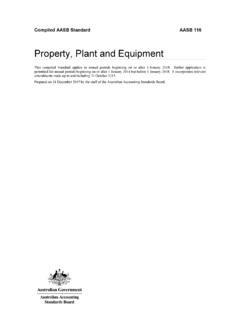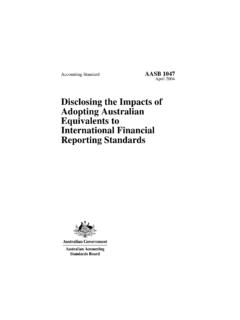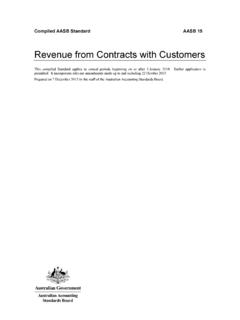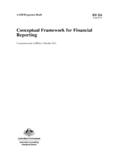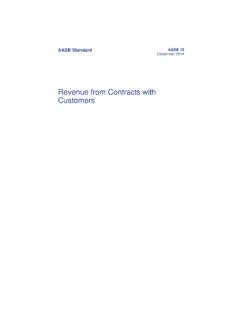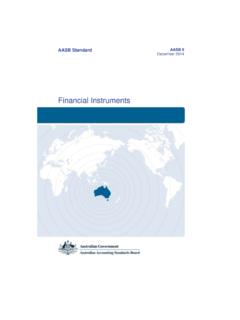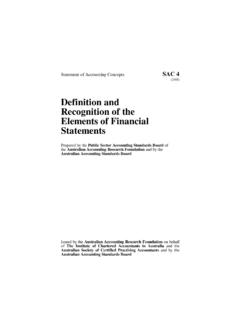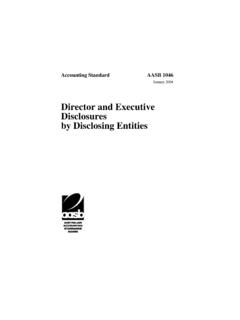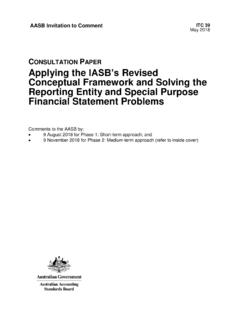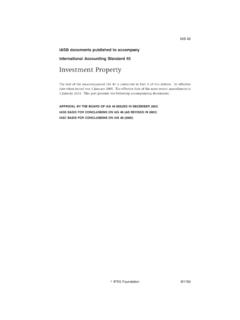Transcription of Compiled AASB 140 (Oct 2015)
1 Compiled AASB Standard AASB 140 investment property This Compiled Standard applies to annual periods beginning on or after 1 January 2018. Earlier application is permitted for annual periods beginning on or after 1 January 2014 but before 1 January 2018. It incorporates relevant amendments made up to and including 22 October 2015. Prepared on 14 December 2015 by the staff of the Australian accounting standards Board. AASB 140- Compiled 2 COPYRIGHT Obtaining copies of accounting standards Compiled versions of standards , original standards and amending standards (see Compilation Details) are available on the AASB website: Australian accounting standards Board PO Box 204 Collins Street West Victoria 8007 AUSTRALIA Phone: (03) 9617 7637 E-mail: Website: Other enquiries Phone: (03) 9617 7600 E-mail: COPYRIGHT Commonwealth of Australia 2015 This Compiled AASB Standard contains IFRS Foundation copyright material.
2 Reproduction within Australia in unaltered form (retaining this notice) is permitted for personal and non-commercial use subject to the inclusion of an acknowledgment of the source. Requests and enquiries concerning reproduction and rights for commercial purposes within Australia should be addressed to The Director of Finance and Administration, Australian accounting standards Board, PO Box 204, Collins Street West, Victoria 8007. All existing rights in this material are reserved outside Australia. Reproduction outside Australia in unaltered form (retaining this notice) is permitted for personal and non-commercial use only. Further information and requests for authorisation to reproduce for commercial purposes outside Australia should be addressed to the IFRS Foundation at AASB 140- Compiled 3 CONTENTS Contents COMPARISON WITH ias 40 accounting STANDARD AASB 140 investment property from paragraph OBJECTIVE 1 SCOPE 2 DEFINITIONS 5 CLASSIFICATION OF property AS investment property OR OWNER-OCCUPIED property 6 RECOGNITION 16 MEASUREMENT AT RECOGNITION 20 MEASUREMENT AFTER RECOGNITION accounting policy 30 Fair value model 33 Inability to measure fair value reliably 53 Cost model 56 TRANSFERS 57 DISPOSALS 66 DISCLOSURE Fair value model and cost model 74 Fair value model 76 Cost model 79 TRANSITIONAL PROVISIONS 80 EFFECTIVE DATE 85 WITHDRAWAL OF ias 40 (2000)
3 86 COMMENCEMENT OF THE LEGISLATIVE INSTRUMENT WITHDRAWAL OF AASB PRONOUNCEMENTS APPENDIX A Australian reduced disclosure requirements COMPILATION DETAILS DELETED ias 40 TEXT AVAILABLE ON THE AASB WEBSITE Basis for Conclusions on ias 40 Australian accounting Standard AASB 140 investment property (as amended) is set out in paragraphs 1 and Appendix A. All the paragraphs have equal authority. Paragraphs in bold type state the main principles. AASB 140 is to be read in the context of other Australian accounting standards , including AASB 1048 Interpretation of standards , which identifies the Australian accounting Interpretations, and AASB 1057 Application of Australian accounting standards . In the absence of explicit guidance, AASB 108 accounting Policies, Changes in accounting Estimates and Errors provides a basis for selecting and applying accounting policies. AASB 140- Compiled 4 COMPARISON Comparison with ias 40 AASB 140 investment property as amended incorporates ias 40 investment property as issued and amended by the international accounting standards Board (IASB).
4 Australian-specific paragraphs (which are not included in ias 40 ) are identified with the prefix Aus or RDR . Paragraphs that apply only to not-for-profit entities begin by identifying their limited applicability. Tier 1 For-profit entities complying with AASB 140 also comply with ias 40 . Not-for-profit entities compliance with ias 40 will depend on whether any Aus paragraphs that specifically apply to not-for-profit entities provide additional guidance or contain applicable requirements that are inconsistent with ias 40 . Tier 2 Entities preparing general purpose financial statements under Australian accounting standards Reduced Disclosure Requirements (Tier 2) will not be in compliance with IFRSs. AASB 1053 Application of Tiers of Australian accounting standards explains the two tiers of reporting requirements. AASB 140- Compiled 5 STANDARD accounting Standard AASB 140 The Australian accounting standards Board made accounting Standard AASB 140 investment property under section 334 of the Corporations Act 2001 on 14 August 2015.
5 This Compiled version of AASB 140 applies to annual periods beginning on or after 1 January 2018. It incorporates relevant amendments contained in other AASB standards made by the AASB up to and including 22 October 201 5 (see Compilation Details). accounting Standard AASB 140 investment property Objective 1 The objective of this Standard is to prescribe the accounting treatment for investment property and related disclosure requirements. Scope 2 This Standard shall be applied in the recognition, measurement and disclosure of investment property . 3 Among other things, this Standard applies to the measurement in a lessee s financial statements of investment property interests held under a lease accounted for as a finance lease and to the measurement in a lessor s financial statements of investment property provided to a lessee under an operating lease. This Standard does not deal with matters covered in AASB 117 Leas es, including: (a) classification of leases as finance leases or operating leases; (b) recognition of lease income from investment property (see also AASB 15 Revenue from Contracts with Customers); (c) measurement in a lessee s financial statements of property interests held under a lease accounted for as an operating lease; (d) measurement in a lessor s financial statements of its net investment in a finance lease; (e) accounting for sale and leaseback transactions; and (f) disclosure about finance leases and operating leases.
6 4 This Standard does not apply to: (a) biological assets related to agricultural activity (see AASB 141 Agriculture and AASB 116 property , Plant and Equipment); and (b) mineral rights and mineral reserves such as oil, natural gas and similar non-regenerative resources. Definitions 5 The following terms are used in this Standard with the meanings specified: Carrying amount is the amount at which an asset is recognised in the statement of financial position. Cost is the amount of cash or cash equivalents paid or the fair value of other consideration given to acquire an asset at the time of its acquisition or construction or, where applicable, the amount attributed to that asset when initially recognised in accordance with the specific requirements of other standards , eg AASB 2 Share-based Payment. Fair value is the price that would be received to sell an asset or paid to transfer a liability in an orderly transaction between market participants at the measurement date.
7 (See AASB 13 Fair Value Measurement). AASB 140- Compiled 6 STANDARD investment property is property (land or a building or part of a building or both) held (by the owner or by the lessee under a finance lease) to earn rentals or for capital appreciation or both, rather than for: (a) use in the production or supply of goods or services or for administrative purposes; or (b) sale in the ordinary course of business. Owner-occupied property is property held (by the owner or by the lessee under a finance lease) for use in the production or supply of goods or services or for administrative purposes. Classification of property as investment property or owner-occupied property 6 A property interest that is held by a lessee under an operating lease may be classified and accounted for as investment property if, and only if, the property would otherwise meet the definition of an investment property and the lessee uses the fair value model set out in paragraphs 33 55 for the asset recognised.
8 This classification alternative is available on a property -by- property basis. However, once this classification alternative is selected for one such property interest held under an operating lease, all property classified as investment property shall be accounted for using the fair value model. When this classification alternative is selected, any interest so classified is included in the disclosures required by paragraphs 74 78. 7 investment property is held to earn rentals or for capital appreciation or both. Therefore, an investment property generates cash flows largely independently of the other assets held by an entity. This distinguishes investment property from owner-occupied property . The production or supply of goods or services (or the use of property for administrative purposes) generates cash flows that are attributable not only to property , but also to other assets used in the production or supply process. AASB 116 applies to owner-occupied property .
9 8 The following are examples of investment property : (a) land held for long-term capital appreciation rather than for short-term sale in the ordinary course of business. (b) land held for a currently undetermined future use. (If an entity has not determined that it will use the land as owner-occupied property or for short-term sale in the ordinary course of business, the land is regarded as held for capital appreciation.) (c) a building owned by the entity (or held by the entity under a finance lease) and leased out under one or more operating leases. (d) a building that is vacant but is held to be leased out under one or more operating leases. (e) property that is being constructed or developed for future use as investment property . 9 The following are examples of items that are not investment property and are therefore outside the scope of this Standard: (a) property intended for sale in the ordinary course of business or in the process of construction or development for such sale (see AASB 102 Inventories), for example, property acquired exclusively with a view to subsequent disposal in the near future or for development and resale.
10 (b) [deleted] (c) owner-occupied property (see AASB 116), including (among other things) property held for future use as owner-occupied property , property held for future development and subsequent use as owner-occupied property , property occupied by employees (whether or not the employees pay rent at market rates) and owner-occupied property awaiting disposal. (d) [deleted] (e) property that is leased to another entity under a finance lease. In respect of not-for-profit entities, property may be held to meet service delivery objectives rather than to earn rental or for capital appreciation. In such situations the property will not meet the definition of investment property and will be accounted for under AASB 116, for example: (a) property held for strategic purposes; and (b) property held to provide a social service, including those which generate cash inflows where the rental revenue is incidental to the purpose for holding the property .
